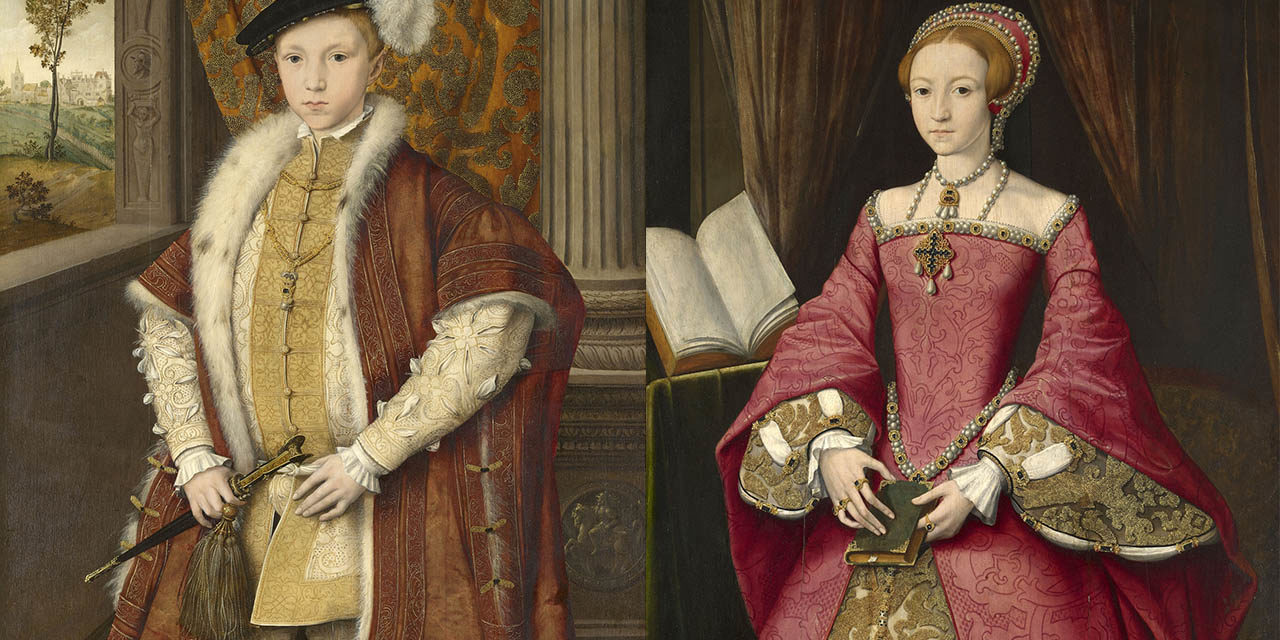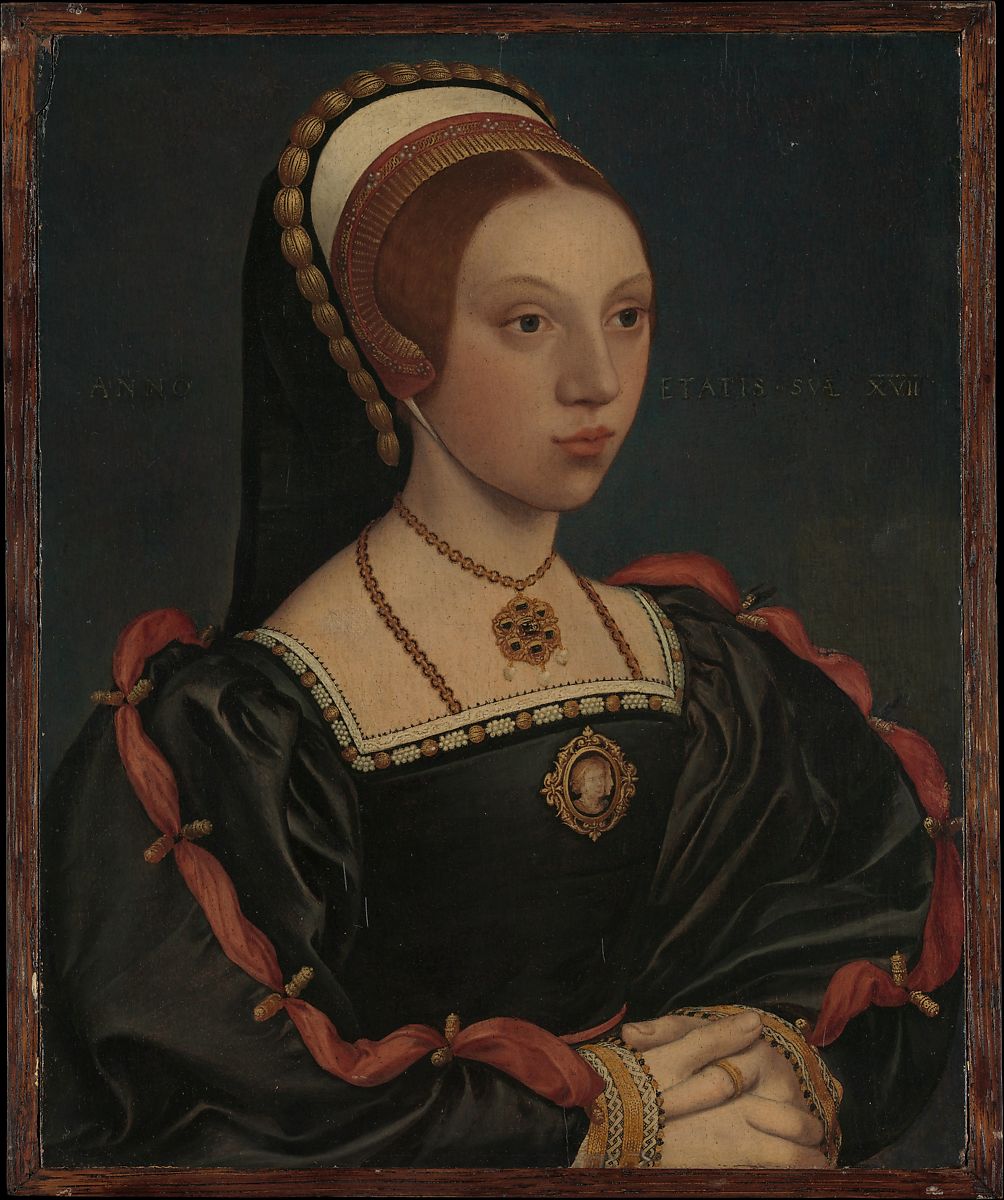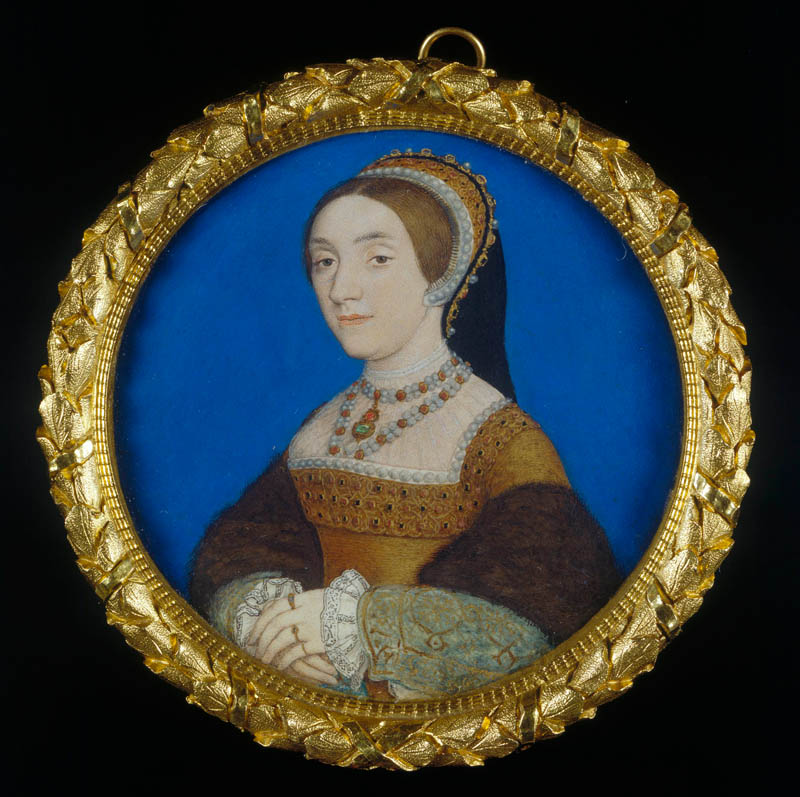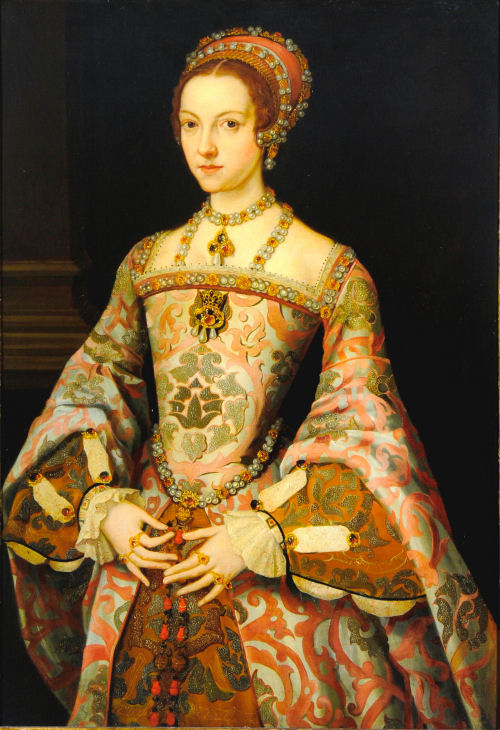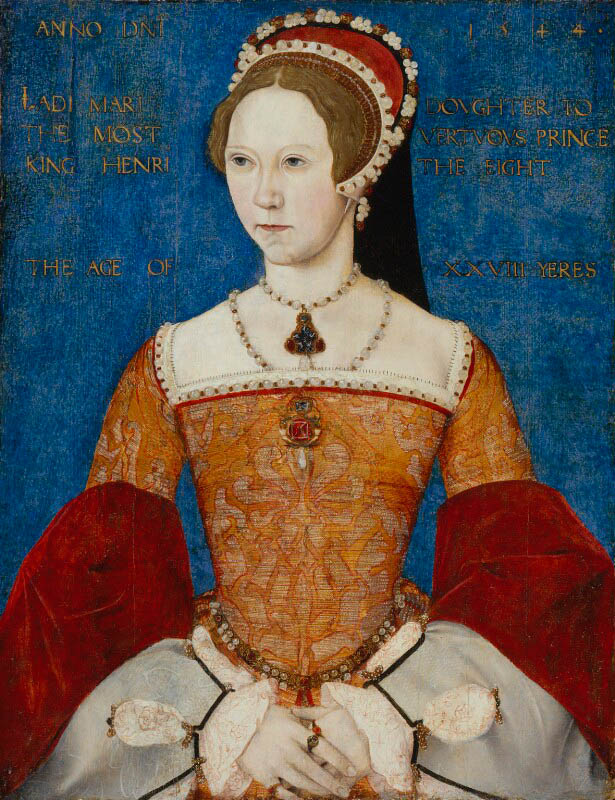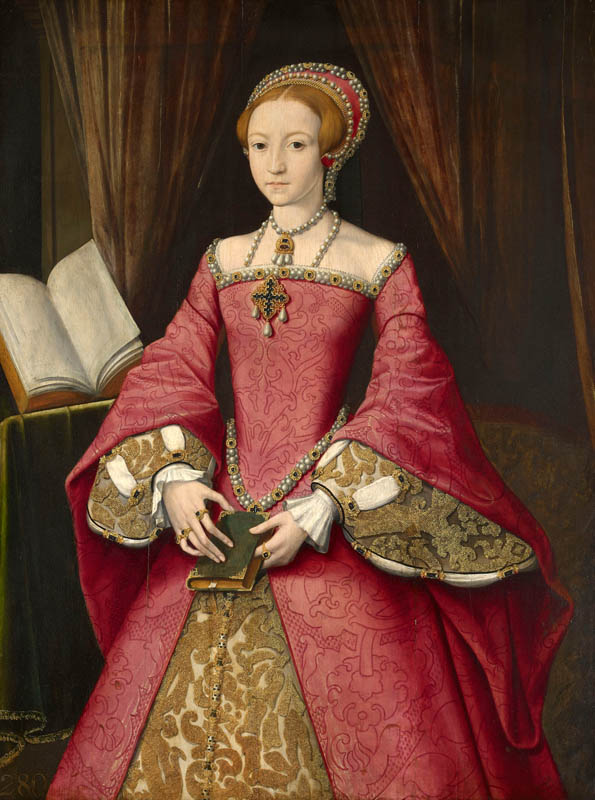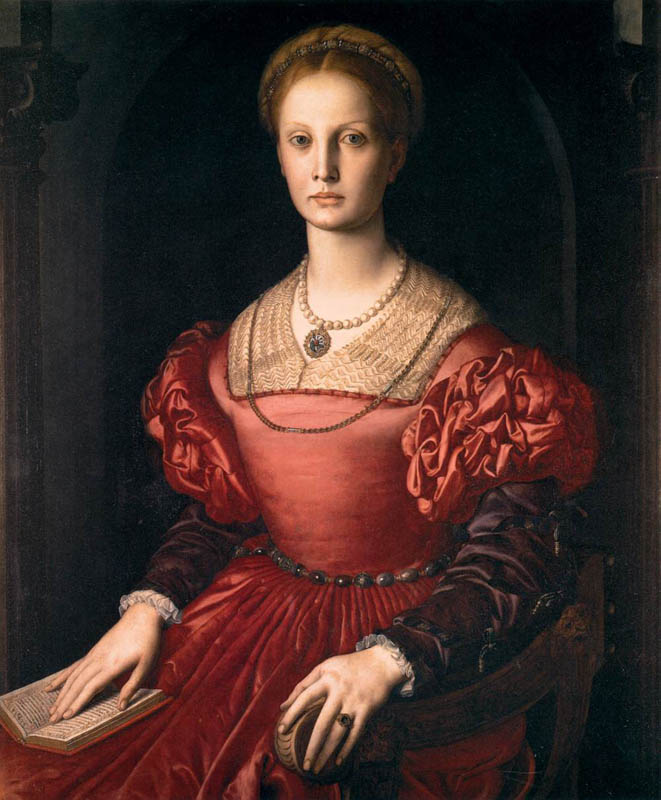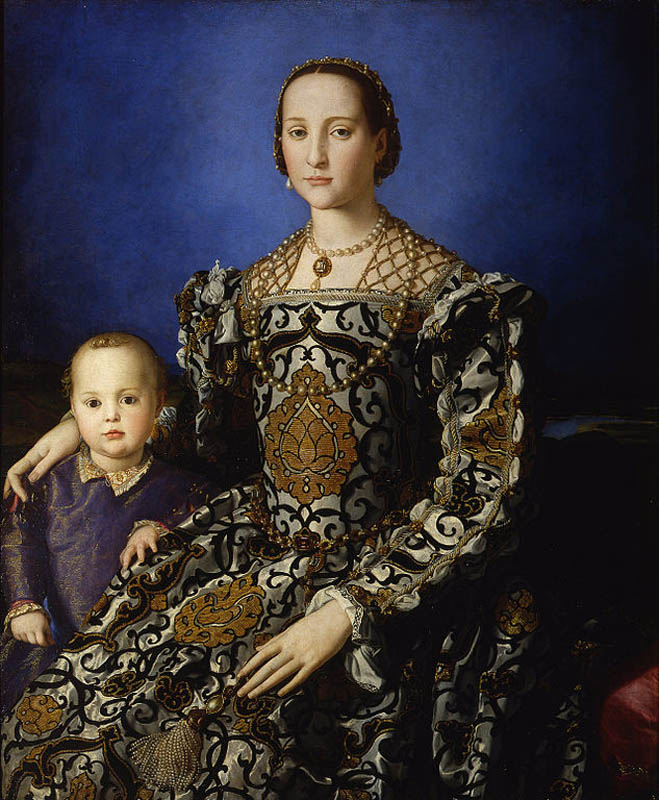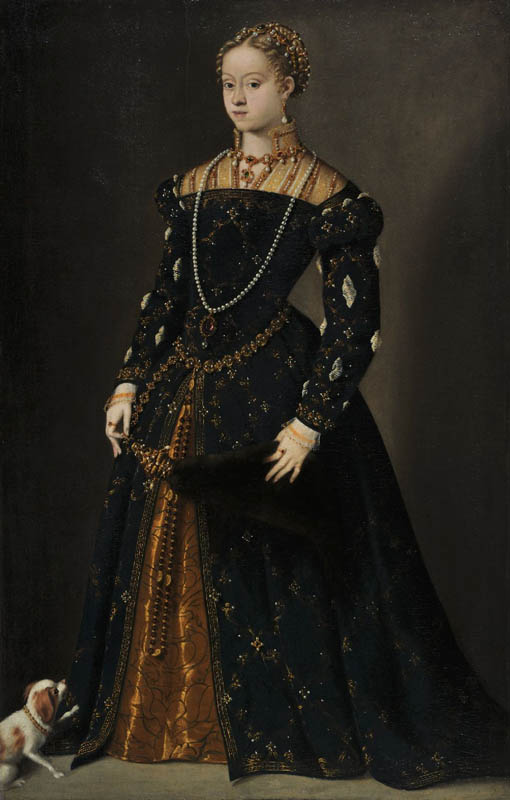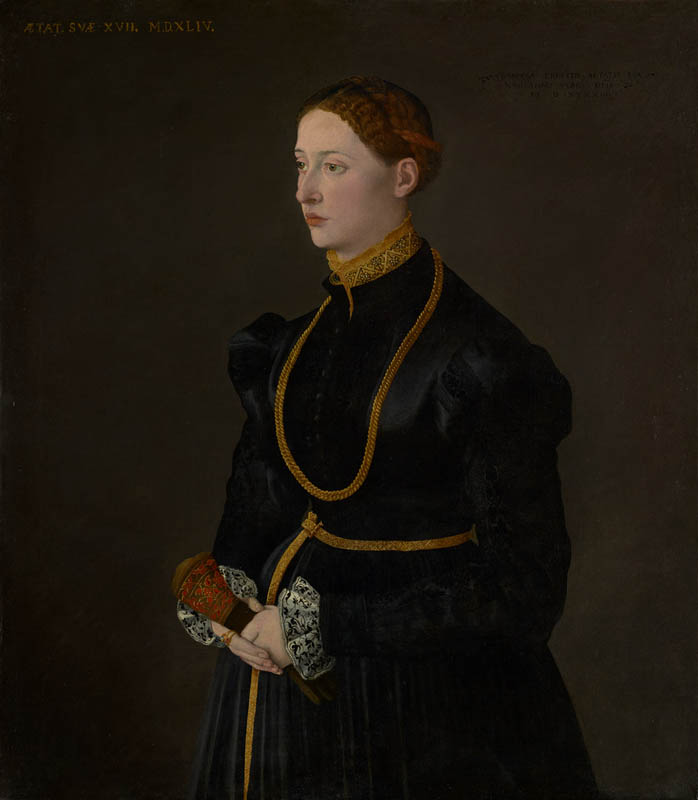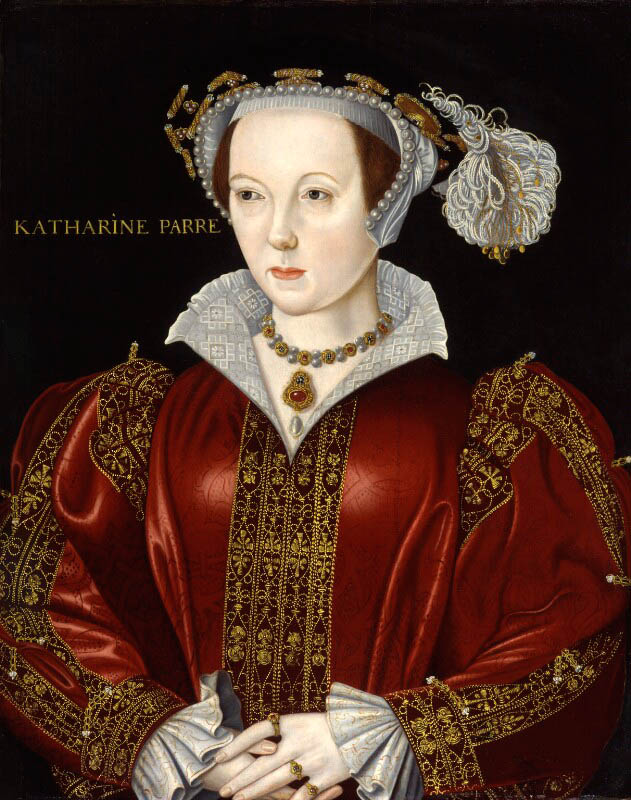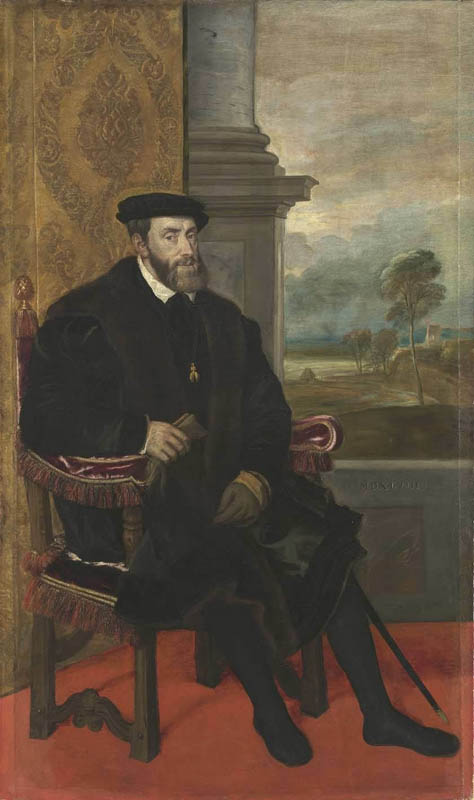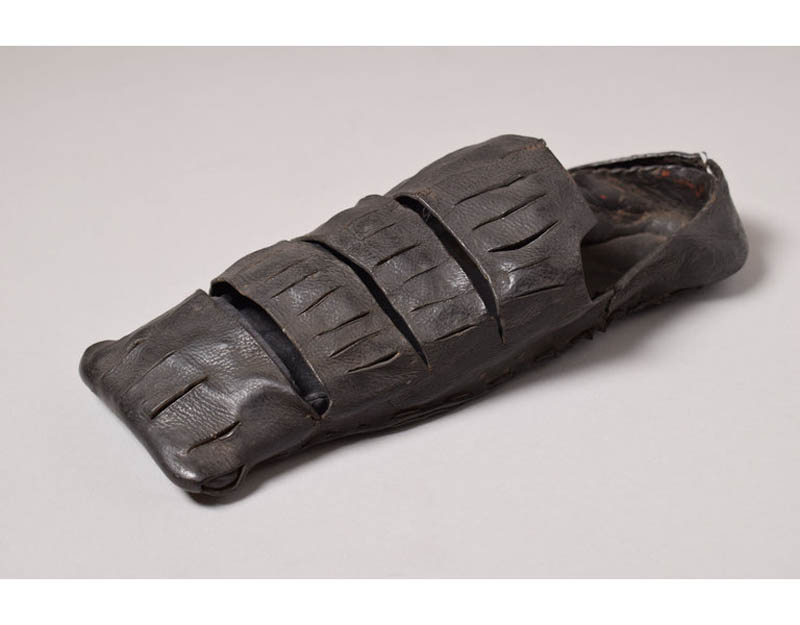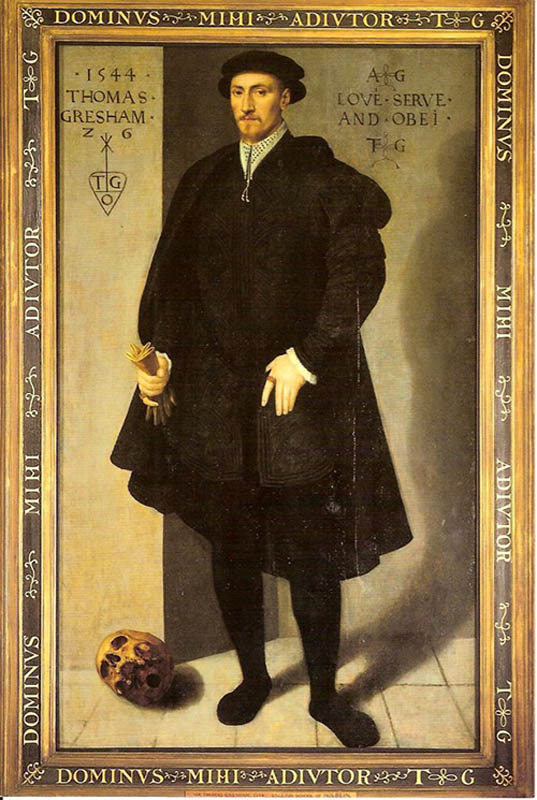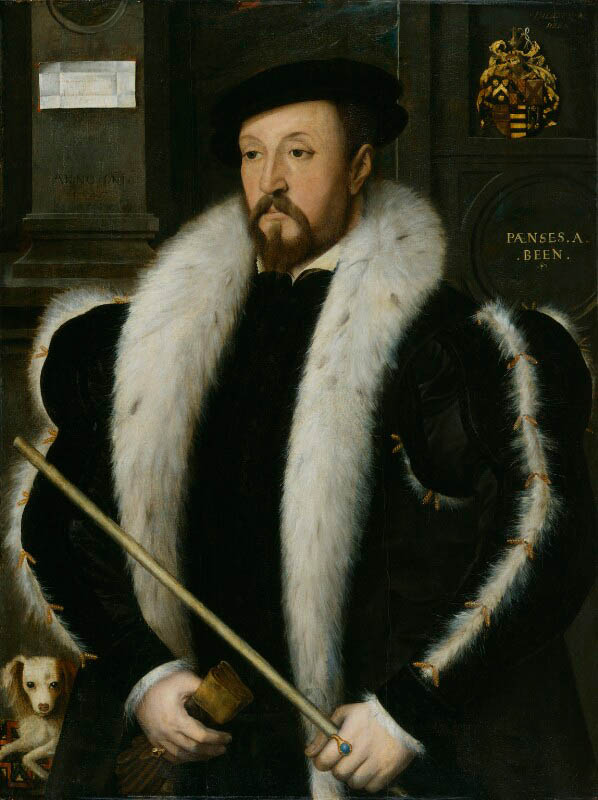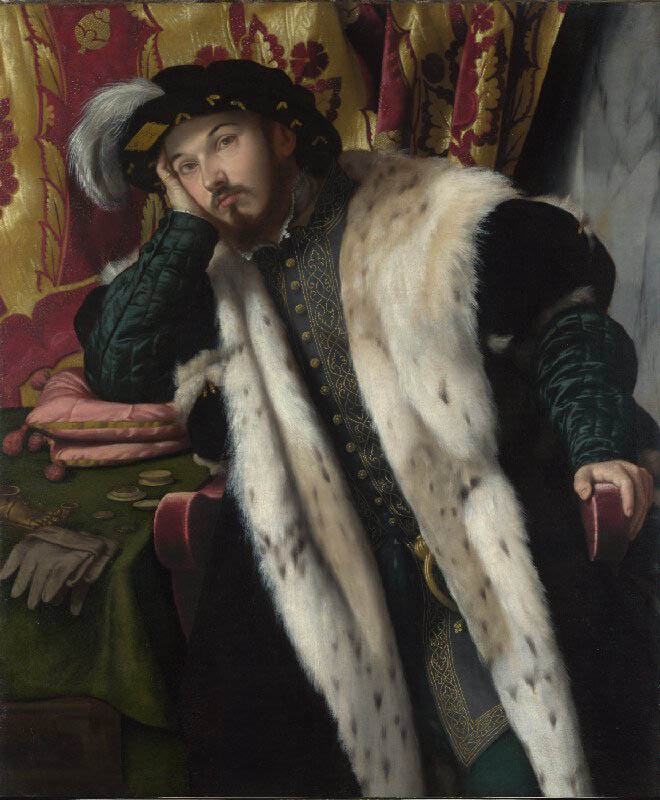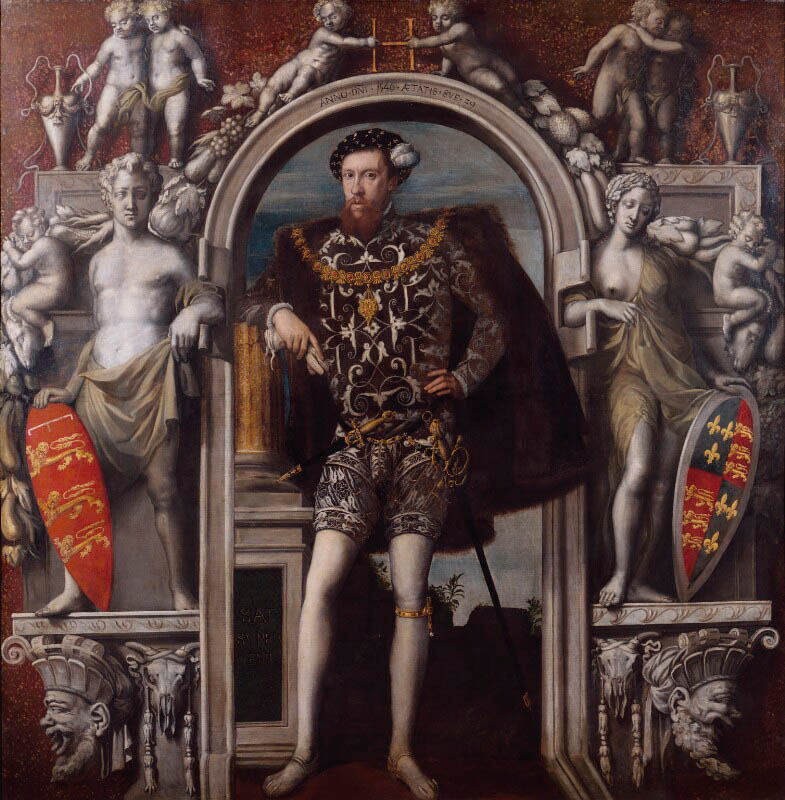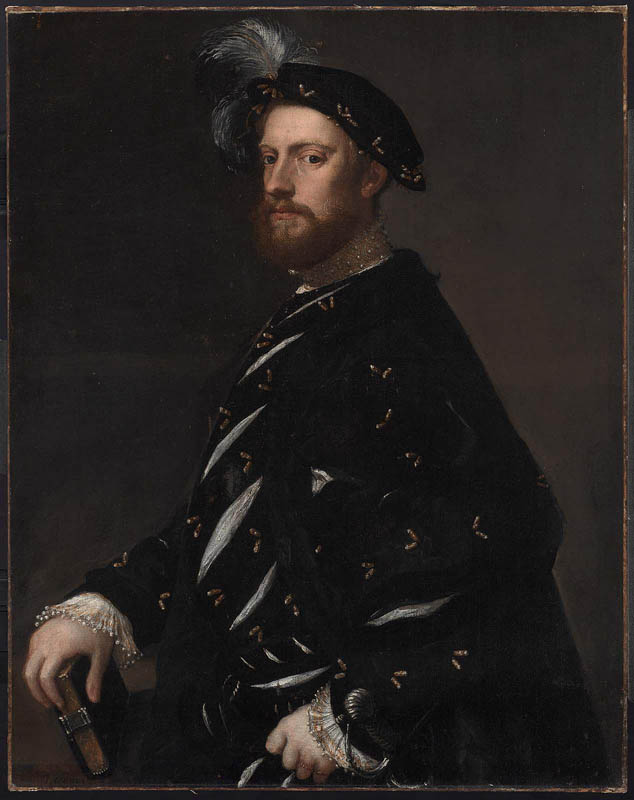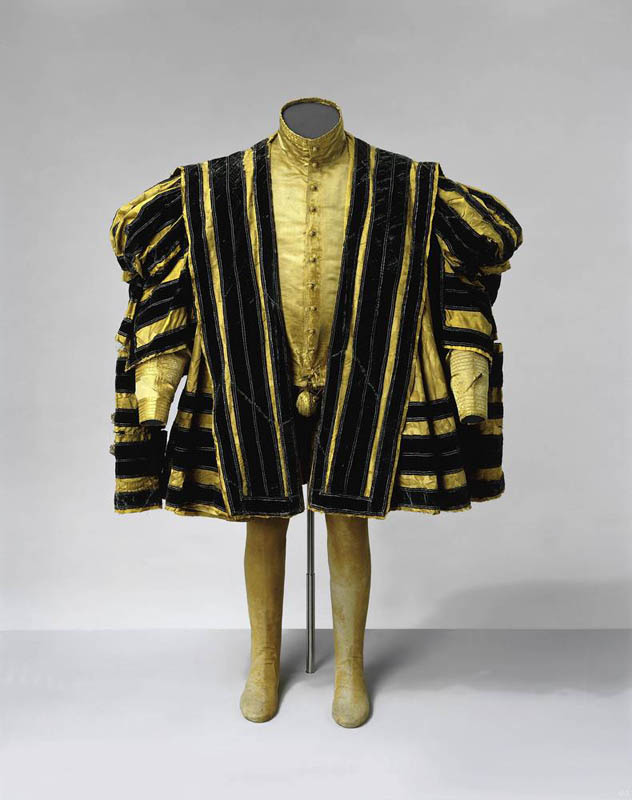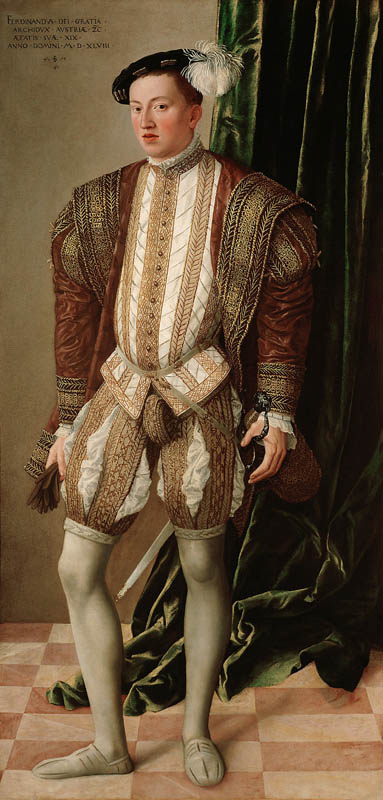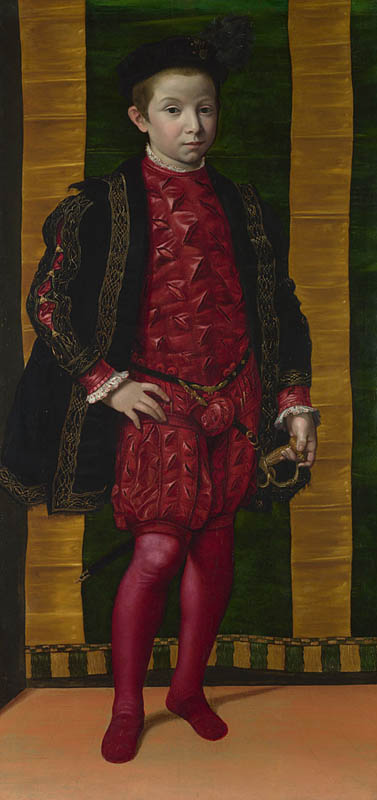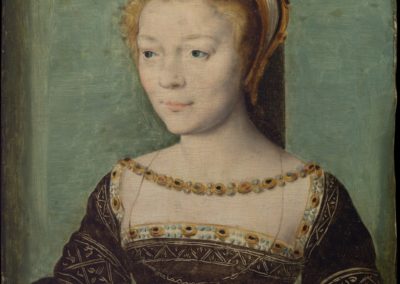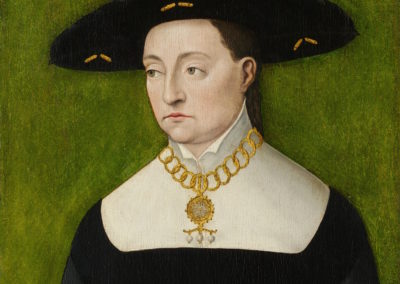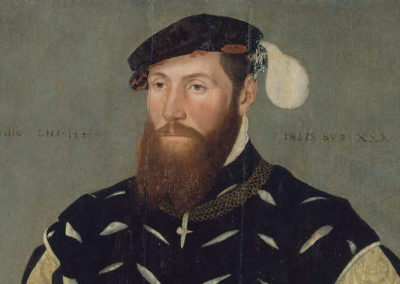OVERVIEW
In the 1540s men’s doublets begin to emerge from under to outerwear and their hose increase in volume, beginning to assume a melon shape. Womenswear becomes increasing rigid with stiffened bodices flattening the torso and breasts.
Womenswear
While the basic components of womenswear remained the same as in earlier decades, the 1540s marked some important shifts in silhouette and terminology as will be explained below. But, first, the key components were: chemise (often decorated with embroidery), kirtle, and gown. Open seams closed by clasps/broaches/aiguillettes were typical sleeve treatments. French hoods were common in France and England; beaded cauls in Italy and caps of various sorts elsewhere. The must-have accessory was the girdle (or decorative belt) to highlight the waist, along with necklaces and rings, but one still finds the zibellino (Fig. 9) and gloves (Figs. 10-11) as well.
While at the start of the 1540s one still found the fuller sleeves worn in the 1530s closed with aiguillettes, like those seen on the unknown woman in a ca. 1540 Holbein portrait (Fig. 1), the silhouette of the decade would soon become dominated by the Spanish farthingale. Daniel Delis Hill explains this shift in his History of World Costume and Fashion (2011):
“The steady mercantile and diplomatic contacts between the English and the courts of the Hapsburg governors in Flanders encouraged Spanish influences in fashions especially during the 1540s and 1550s.” (376)
This adoption of Spanish elements meant the displacement of German ones, as François Boucher elaborates in A History of Costume in the West (1997):
“Towards 1540-45 English costume, moving away from German models, which incidentally were then disappearing almost completely throughout Europe, became influenced by Spanish styles.” (244)
The French hood (Figs. 1-5) became the dominant headdress style in England, worn by both of Henry VIII’s last two wives, Katherine Howard (Fig. 2) and Katherine Parr (Fig. 3, also Fashion Icon below). Howard wears a very fine linen partlet to fill in the square neckline of her gown with the funnel-shaped sleeves and large turned-back cuffs that became standard in the 1540s (Figs. 2-5).
The Spanish farthingale had been worn in Spain since the end of the 15th century, but as Anna Reynolds notes in In Fine Style: The Art of Tudor and Stuart Fashion (2013):
“Farthingales were probably not extensively adopted in England until the 1540s, and are first recorded in the Royal Wardrobe accounts of 1545” (41).
This rigid cone-shaped understructure stiffened the silhouette as Jane Ashelford remarks in A Visual History of Costume (1983):
“From about 1545 to 1550 … Female dress now consists of two distinct parts – a stiffened bodice and a skirt the rigid shape of which was dictated by the farthingale underneath.” (58)
Parr (Fig. 3), Queen Mary I (Fig. 4) and Princess Elizabeth I (Fig. 5) all wear this distinctive silhouette where the cone of the skirt was echoed in the giant funnel shaped sleeves, which accentuated the narrow waist. There was a shift in terminology as well as construction as Reynolds explains:
“By the second half of the sixteenth century… the kirtle referred only to a skirt, with the stiffened top half being more frequently termed a pair of bodies (later bodice).” (39)
The funnel-shaped sleeves of the gown were accentuated by equally large undersleeves typically made of the same rich fabric as the forepart (or the visible part of the kirtle viewed in the inverted-V shape opening of the gown). These undersleeves were often decorated with open seams closed by broaches (rather than the Germanic slashes). Princess Elizabeth’s undersleeves and forepart are in a silver-gray satin and a raised gold brocade (Fig. 5).
Sleeves were cut very close to the top of the arm and were extremely narrow before opening into the funnel shape. The waist was nearly always accentuated by a girdle—a jeweled one if royalty. Jewels also were used to line the square-cut bodice and the edges of the French hood. The downward curve of the bodice will later become a pronounced V-shape (Ashelford 49). Delicate embroidery in black (Spanish blackwork) and other color threads remains very common on the chemise.
In Italy
Italian women also adopted elements of Spanish fashion in the 1540s as Hill explains:
“Spanish influence on women’s fashions of Italy included the padded, corseted bodice with its pointed waist and the conical profile of the skirt. Instead of adapting the structured farthingale for a smooth, rigid skirt line, though, Italian court ladies preferred the softer draping of pleats and gathers.” (362)
This intense use of pleating at the waist can be seen in Bronzino’s portrait of Lucrezia Panciatichi (Fig. 6). Hill further remarks that: “In addition, sumptuously patterned Italian fabrics were favored over the somber, dark solids of the Spanish designs.” (362)
Eleanora of Toledo (Fig. 7), a Spanish noblewoman who married Cosimo I de’ Medici and became Duchess of Florence, perfectly blends Spanish and Italian fashion. Her bodice is extremely rigid in the Spanish style but made of a rich Italian brocade. A velvet of a very similar design from the same period still survives (Fig. 8). She has blackwork embroidery on her chemise and a gold braid partlet fills in the square-cut bodice.
Fig. 1 - Workshop of Hans Holbein the Younger (German). Portrait of a Young Woman, ca. 1540-45. Oil and gold on oak; 28.3 x 23.2 cm (11 1/8 x 9 1/8 in). New York: The Metropolitan Museum of Art, 49.7.30. The Jules Bache Collection, 1949. Source: The Met
Fig. 2 - Hans Holbein the Younger (German, 1497-1543). Portrait of a Lady, perhaps Katherine Howard, ca. 1540. Watercolour on vellum laid on playing card; 6.3 cm. Royal Collection Trust, RCIN 422293. Source: RCT
Fig. 3 - Artist unknown. Melton Constable portrait, thought to be Queen Katherine Parr, 16th century. Source: Tudor Queen
Fig. 4 - Master John (English Tudor Court Painter, active 1544-45). Queen Mary I, 1544. Oil on panel; 71.1 x 50.8 cm (28 x 20 in). London: National Portrait Gallery, NPG 428. Purchased, 1876. Source: NPG
Fig. 5 - William Scrots (active 1537-53). Elizabeth I when a Princess, ca. 1546. Oil on panel; 108.5 x 81.8 cm. Windsor Castle, RCIN 404444. Source: Royal Collection Trust
Fig. 6 - Bronzino (Florentine, 1503-1572). Portrait of Lucrezia Panciatichi, ca. 1540. Oil on panel; 102 x 85 cm (40.1 x 33.4 in). Florence: Uffizi Gallery, 736. Source: Wikipedia
Fig. 7 - Bronzino (Florentine, 1503-1572). Portrait of Eleonora of Toledo with her son Giovanni de Medici, 1544-45. Oil on panel; 115 x 96 cm (45.2 x 37.7 in). Florence: The Uffizi Gallery, 748. Source: Wikipedia
Fig. 8 - Designer unknown (Italian). Patterned velvet on silver ground with silver and gold brocade effect, 16th century. Florence: Museo del Bargello. Source: Pins and Needles
Fig. 9 - Titian (Venetian, 1488-1576). Katharina von Österreich, 1548-49. Oil on canvas; 176 x 112 cm. Oelsnitz: Museeen Schloss Voitgtsberg. Source: Museeen Schloss Voitgtsberg
In the Holy Roman Empire
The Holy Roman Empire in this period included Spain, the Netherlands/Low Countries, parts of Italy and Germany, as well as Austria. Catherine of Austria (Fig. 9) was one of the fifteen children of Ferdinand I, Holy Roman Emperor and Anna of Bohemia and Hungary. Her dress includes trends already seen like rigid bodice, the sleeves cut very close to the top of the arm, the chemise/partlet filling in the neckline, the gown opening to reveal a rich forepart, and the girdle. Her sleeves are narrower and involve slashing and puffing out the chemise fabric; this narrower sleeve style with an emphasis on the slightly bulbous upper almost cap-sleeve will become common in the 1550s.
By the 1540s the exuberance of Germanic dress of the 1520s and 1530s began to die down, perhaps influenced by the spreading Protestant Reformation. Sleeves remained narrow, but were more frequently plain (Figs. 10-12), rather than banded and slashed and puffed as they had been before. Colors became more somber and necklines remained high. The portrait of Barbara Kressin (Fig. 10) is striking in its severity—the deep black of her gown draws attention to her golden girdle and necklace, as well as the dramatic blackwork embroidery at her cuffs and collars. She holds leather gloves ornamented with gold and pink embroidered flowers. The unknown girl in the Pencz portrait shares the same decorative details—blackwork on the chemise, embroidered gloves—and maintains the German tradition of wearing multiple rings. Her high chemise collar has a pronounced frill that already begins to resemble the figure-8 of a ruff. A 19-year old woman (Fig. 12) also wears five rings and a modest, high-necked gown.
Fig. 10 - Artist unknown (Netherlandish). Portrait of Barbara Kressin, 1544. Oil on canvas; 110.5 x 96.5 cm (43 1/2 x 38 in). Los Angeles: J. Paul Getty Museum, 70.PA.54. Source: Getty
Fig. 11 - Georg Pencz (German, 1500-1550). Portrait of a Girl, 1547. Oil on canvas; 61.28 x 49.85 cm (24 1/8 x 19 5/8 in). Minneapolis Institute of Art, 68.41.5. Bequest of Miss Tessie Jones in memory of Herschel V. Jones. Source: MIA
Fig. 12 - Follower of Maarten van Heemskerck (Netherlandish, 1498-1574). Portrait of a Nineteen-Year-Old Woman, 1548. Oil on panel; 71.6 x 53.5 cm (23 3/16 x 21 1/16 in). Philadelphia Museum of Art, Cat. 416. John G. Johnson Collection, 1917. Source: PMA
Fashion Icon: Katherine Parr, Queen of England
Fig. 1 - Master John (English Tudor Court Painter, active 1544-45). Katherine Parr, ca. 1545. Oil on panel; 180.3 x 94 cm (71 x 37 in). London: National Portrait Gallery, NPG 4451. Purchased with help from the Gulbenkian Foundation, 1965. Source: NPG
Fig. 2 - Artist unknown. Katherine Parr, late 16th century. Oil on panel; 63.5 x 50.8 cm (25 x 20 in). London: National Portrait Gallery, NPG 4618. Purchased with help from the Art Fund, the Pilgrim Trust, H.M. Government and Gooden & Fox Ltd, 1968. Source: NPG
We’ve already seen one portrait of Katherine Parr above (Fig. 3), where her love of sumptuous textiles and fashionability is clear. She married Henry VIII in July 1543 and had already been married twice before. She was an involved stepmother to Mary (Fig. 4) and Elizabeth (Fig. 5), whom she convinced Henry to restore to the line of succession.
Tudor Times quotes a description of Katherine in 1544 by de Gante, the Secretary to the Duke of Najera:
“She is of a lively and pleasing appearance and is praised as a virtuous woman. She was dressed in a robe of cloth of gold and a petticoat of brocade with sleeves lined with crimson satin and trimmed with three-piled crimson velvet. Her train was more than two yards long. Suspended from her neck were two crosses, and a jewel of very rich diamonds and in her head-dress were many and beautiful ones. Her girdle was of gold with large pendants.”
De Gante could also be describing her dress in a portrait by Master John (Fig. 1), where Parr wears a “cloth of silver tissue woven with a very large repeat pomegranate design” (Hayward 185). She wears a Spanish farthingale and stiffened bodice the comes to a point such that it almost transforms the silhouette into two intersecting triangles. The cuffs of her funnel sleeves are lined in luxurious lynx fur. Her chemise is decorated with redwork embroidery visible in the open seams and at the cuffs. The dress is at the height of luxury and style of the times, as befits a queen.
Her favorite colors for clothes were apparently crimson, black and violet (Tudor Times) and we see her dressed in crimson in another confirmed portrait (Fig. 2). In the portrait we see a use of gold braid which was common at the time as Ashelford explains:
“The decoration on this lady’s elegant costume is typical of the taste in the mid-to-late 1540s for an interlaced pattern of gold braid or cord set against a darker background.” (51)
She wears a very masculine style black bonnet with halo brim, like that favored by Henry VIII in fact (see Fashion Icon, 1530-1539). This adoption of masculine styling in womenswear would become a fashionable trend. A confident woman, who outlived Henry and would go on to marry a fourth time, Katherine Parr used dress to signal and reinforce her status in a powerful, and typically Tudor, way.
Menswear
The principal garments worn by men in this period remained unchanged from earlier in the century, with the foundation being a shirt, with a doublet worn on top; this could be topped by a jerkin, but slowly we’ll begin to see doublets worn alone. Men wore hose to cover the upper part of their legs; the join between the two legs was embellished with a codpiece. On their lower legs they wore stockings, which could now be knit, as well as shoes of fabric or leather that were often slashed. As outwear, men also wore loose-fitting and often fur-lined gowns, but we’ll begin to see the increasing use of the cape (sleeved or sleeveless) as well. Accessories included a bonnet or cap, sword, dagger, and gloves by this period.
The fashionability of black and other somber colors was only increasing in the 1540s. That said, some also wore it as a symbolic rejection of fashion, though it remained a status symbol as black dye remained one of the most expensive. The Holy Roman Emperor Charles V (Fig. 1) was never a keen clotheshorse and in a 1548 portrait by Titian we see him clad uniformly in black, save his white shirt collar. He had been at war continually with the Ottoman Empire and involved in the 1540s with the Counter-Reformation so the severity of dress and rejection of decorative flourish is not surprising. His shoes, though somewhat blunt-toed are more closely following the natural line of the foot, as the reign of the duckbill (Fig. 2) was waning.
Thomas Gresham (Fig. 3), a merchant at the English court, shows a similar sartorial severity in his dress, though he adds back the decorative ornament Charles V rejected. As Maria Hayward notes in Dress at the Court of Henry VIII (2007), Gresham wears the “elegant black clothes favoured by the merchants associated with the royal court” and his “doublet and gown are heavily embroidered in black silk, so creating a sense of understated wealth and taste” (36-37). Gresham is notable as a textile importer and is said to have given the young King Edward VI his first knitted silk stockings as his “trade with the Low Countries brought him into contact with such Spanish goods” (Davenport 436).
Fig. 1 - Titian (Venetian, 1488-1576). Portrait of Charles V, 1548. Oil on canvas; 203.5 × 122 cm (80.1 × 48 in). Munich: Alte Pinakothek. Source: Alte Pinakothek
Fig. 2 - Maker unknown. Shoe, ca. 1520-40. Tanned leather. London: Victoria & Albert Museum, T.412-1913. Given by Messrs Harrods Ltd.. Source: V&A
Fig. 3 - Artist unknown (Flemish). Sir Thomas Gresham, 1544. Oil on canvas. Gresham College. Source: London Historians' Blog
Fig. 4 - Artist unknown (Anglo-Netherlandish). Thomas Wentworth, 1st Baron Wentworth, ca. 1547-50. Oil on panel; 77.1 x 73.4 cm (30 3/8 x 28 7/8 in). London: National Portrait Gallery, NPG 1851. Purchased, 1919. Source: NPG
Fig. 5 - Moretto da Brescia (Italian, 1498-1554). Portrait of Count Fortunato Martinengo, ca. 1540-45. Oil on canvas; 114 x 94.4 cm. London: National Gallery, NG299. Bought, 1858. Source: National Gallery
Thomas Wentworth (Fig. 4) also served at the court of Henry VIII and Edward VI, for whom he was Lord Chamberlain. His ensemble is monochromatic but luxe as it is lined in what appears to be lynx fur. Such sleeve treatments, where the fur would be puffed out through the open seams which were closed by aiguillettes, were popular for both men and women (Ashelford 54).
In Italy
Another version can be seen in Moretto da Brescia’s portrait of Count Fortunato Martinengo (Fig. 5), though notably Martinengo’s doublet sleeves are dark green rather than black. His jerkin still has a sizable skirt and is ornamented with applied gold cord or golden embroidery, similar to that seen on Katherine Parr (see Fig. 2 in the Fashion Icon section above). He still wears a black bonnet ornamented with a white feather and aiguillettes as indeed many men still do (Figs. 5-7, 12-13).
Fig. 6 - Artist unknown (Italian). Henry Howard, Earl of Surrey, 1546. Oil on canvas; 222.3 x 219.7 cm (87 1/2 x 86 1/2 in). London: National Portrait Gallery, NPG 5291. Source: NPG
Fig. 7 - TItian (Venetian, 1488-1576). Portrait of a Man Holding a Book, ca. 1540. Oil on canvas; 97.8 x 77.2 cm (38 1/2 x 30 3/8 in). Boston: Museum of Fine Arts, 43.83. Charles Potter Kling Fund. Source: MFA Boston
Fig. 8 - Bernardino Licinio (Venetian, 1485-1550). Ottaviano Grimani, 1541. Oil on canvas; 115.2 x 96 cm. Vienna: Kunsthistoriches Museum, 1567. Source: KHM
Henry Howard (Fig. 6), Earl of Surrey, was English but did not conform to English fashions as Ashelford explains:
“Surrey was renowned for his extravagant taste in dress; he wears an Italian fashion and adopts an Italianate pose. One of the charges at his trial in 1547 was that he wore foreign dress. He was found guilty of treason and executed. His spectacular Garter collar was worn by Edward VI at his Coronation.” (57)
He wears an extremely tight-fitting black doublet and hose covered in an elaborate white floriated design. Titian’s portrait of a man holding a book (Fig. 7) shows the Italian model that Surrey was following. Italy, under influence from Spain, had been embracing black for some time. Here the black is broken up by slashing that reveals the white of the shirt and by decorative golden aiguillettes. He has elaborate gold embroidery on the high standing collar of his shirt, which ends in a frill.
Ottaviano Grimani, the Procurator of Saint Mark’s in Venice shares little of that sartorial sobriety, however, as De Marly remarks in Fashion for Men (1985):
“The doublet had crossed over from underwear to outer wear, and here forms part of a leather suit with fur on the inside. The Italians preferred a sloping shoulderline to the northern square one. The breeches are in mi-parti, with even the codpiece in two tones. No wonder Luther and Calvin said the Catholic Church lacked morality and modesty.” (33)
His doublet is also extensively slashed, which also remained quite fashionable in Germany.
Fig. 9 - Maker unknown (Italian). Parade Garments of Elector Moritz of Saxony, ca. 1545-50. Yellow silk satin and silk velvet; yellow chamois leather. Dresden: Residenzschloss. Photo by M. McNealy. Source: Facebook
Fig. 10 - Georg Pencz (German, 1500-1550). Portrait of a Young Man, 1544. Oil on panel; 91 x 70 cm (35.8 x 27.5 in). Florence: Uffizi Gallery. Source: Wikipedia
Fig. 11 - Probably Nicol Basemer. Parade Garments of Elector Moritz of Saxony, ca. 1545-50. Yellow silk damask. Dresden: Staatliche Kunstsammlungen, i.0001.01. Source: SKD
Fig. 12 - Jakob Seisenegger (Austrian, 1505-1567). Archduke Ferdinand II (1529-1595) as Governor of Bohemia, 1548. Oil on canvas; 184.5 x 89 cm. Vienna: Kunsthistorisches Museum, 5947. Source: KHM
Fig. 13 - William Scrots (active 1537-53). Edward VI (1537-53), ca. 1546-47. Oil on panel; 107.2 x 82 cm. Windsor Castle, RCIN 404441. Source: Royal Collection Trust
In Germany
A very rare surviving set of garments from the 1540s allow us to see what 16th-century menswear was actually like. The parade garments of Elector Moritz of Saxony (Figs. 9, 11) date to 1545-50 and are in a striking yellow silk. The doublet is extensively slashed on the sleeves (Fig. 9) and is paired with trunk hose that is paned (with pinking notching the panes all the way down). The Cunningtons describe this early trunk hose in their Handbook of English Costume in the Sixteenth Century (1954):
“[1540-1560]. The upper stocks or breech, fitting above, were ovally distended from the fork to mid-thigh or lower. The distensions were usually paned. These were the forerunners of the true trunk hose…in which the fulness began at the waist.” (35)
The codpiece remains prominent, as indeed it does in Georg Pencz’s 1544 portrait of a young man (Fig. 10), where the doublet sleeves are slashed diagonally as in the parade garments and the skirted, sleeveless jerkin is more regularly horizontally pinked. Both feature high standing collars and Pencz’s white frill of the shirt would have also featured in the parade dress. The look is completed with the addition of a broad-shouldered gown with hanging sleeves and ornamented with black velvet stripes (Fig. 11). This silhouette is more typical of the 1530s, but parade dress would tend to be more conservative in its cut.
The doublet’s very short peplum or skirt was, however, very on trend for the time as Hill explains:
“Although men’s short, skirted jackets and knee-length bases remained popular in northern Europe much longer than in Spain and Italy, the new silhouettes of German trunk hose (as adapted from the Spanish styles) and cropped, narrow jackets began to supplant the remnants of Gothic styles in the 1540s.” (376)
Indeed, we can see this shift by contrasting the dress of Archduke Ferdinand II of the Holy Roman Empire with that of future English King Edward VI. Ferdinand wears a doublet with a very short peplum, whereas Edward continues to wear a jerkin with a much longer skirt overtop his doublet. As De Marly remarks, there is a shift away from the hypermasculine broadness of silhouette popularized by Henry VIII:
“In the 1540s the width of the square looks begins to modify towards more natural dimensions.” (34)
Both young men wear the very short hair style introduced by the Germans (De Marly 34). But Ferdinand is dressed in what was to be the dominant silhouette of the 1550s:
“doublet with longer waistline, shorter skirts, dropped shoulderline, simplified sleeves, braiding in vertical lines; paned hose, with a little bombast set low.” (Davenport 410)
CHILDREN’S WEAR
As the discussion of Edward VI above should make clear (Fig. 13), there was little notion of children’s wear in the 16th century. Edward at 9 was dressed like his father at 55. Bia de’ Medici (Fig. 1) wears a dress that could be worn in a larger size by her stepmother, Duchess Eleonora (see Fig. 7 above, which also includes a portrait of Giovanni). The chubby-faced Giovanni de’ Medici (Fig. 2) demonstrates that some concessions to childhood (and climate) could be made as he wears no gown or cape as outerwear. He also, as a toddler, does not carry a sword, but this must-have accessory would appear in children’s portraits, as it does in the rich portrait of an unknown Florentine boy (Fig. 3), who does wear a gown and codpiece as well. He wears pumpkin or melon hose, as does the boy in a Moroni portrait of about the same time (Fig. 4). The presumed father and son’s shirt collars are quite similar. Thus, while some concessions could be made to children’s extreme youth—as babies they were typically swaddled and then dressed in gowns no matter the gender—as soon as possible children were dressed as miniature adults.
Fig. 1 - Bronzino (Florentine, 1503-1572). Portrait of Bia de' Medici, 1542-45. Oil on panel; 63.3 x 48 cm. Florence: Uffizi Gallery, 1890 n.1472. Source: Uffizi
Fig. 2 - Bronzino (Florentine, 1503-1572). Giovanni de' Medici as a Child, 1545. Tempera on panel; 58 × 45 cm (22.8 × 17.7 in). Florence: Uffizi Gallery. Source: Wikipedia
Fig. 3 - Artist unknown (Florentine). Portrait of a Boy, ca. 1545. Oil on wood; 129 x 61 cm. London: National Gallery, NG649. Bought, 1860. Source: National Gallery
Fig. 4 - Giovanni Battista Moroni (Italian, 1520-1578). Portrait of a Man and a Boy (Count Alborghetti & Son), ca. 1545-50. Oil on canvas; 98.1 x 83.5 cm (38 5/8 x 32 7/8 in). Boston: Museum of Fine Arts, 95.1371. Museum purchase with funds donated by Mrs. Turner Sargent (Amelia J. Holmes)—Turner Sargent Fund. Source: MFA Boston
References:
- Ashelford, Jane. A Visual History of Costume: The Sixteenth Century. London: Batsford, 1983. http://www.worldcat.org/oclc/748457696.
- Boucher, François, Yvonne Deslandres, and John Ross. A History of Costume in the West: With 1188 Illustrations, 365 in Colour. London: Thames and Hudson, 1997. http://www.worldcat.org/oclc/443676264.
- Cunnington, C. Willett, and Phillis Cunnington. Handbook of English Costume in the Sixteenth Century. London: Faber and Faber, 1954. http://www.worldcat.org/oclc/362761.
- Davenport, Millia. The Book of Costume. New York: Crown Publishers, 1948. http://www.worldcat.org/oclc/922657048.
- De Marly, Diana. Fashion for Men: An Illustrated History. London: B.T. Batsford Ltd, 1985. http://www.worldcat.org/oclc/752978274.
- Hayward, Maria, ed. Dress at the Court of King Henry VIII. Leeds: Maney, 2007. http://www.worldcat.org/oclc/997437672.
- Hill, Daniel Delis. History of World Costume and Fashion. Upper Saddle River, NJ: Pearson Prentice Hall, 2011. http://www.worldcat.org/oclc/768100950.
- “Katherine Parr: Appearance – What Did Katherine Look Like?” Tudor Times. Accessed July 1, 2019. http://tudortimes.co.uk/people/katherine-parr-appearance.
- Reynolds, Anna. In Fine Style: The Art of Tudor and Stuart Fashion. London: Royal Collection Trust, 2013. http://www.worldcat.org/oclc/824726826.
Historical Context
Wikipedia: 1540-1549
Rulers:
- France
- England
- King Henry VIII (1509-1547)
- King Edward VI (1547-1553)
- Spain
- House of Trastamara (1479-1555)
- Queen Joanna (1516-1555) in Aragon/Castile
- House of Habsburg (1516-1700)
- King Charles V&I (1516-1556)
- House of Trastamara (1479-1555)
Habsburg Map 1547. Source: Wikimedia
Events:
- 1540 – The codpiece reaches its peak in terms of size and decoration. Designed to cover the gap between the two legs of men’s hose, it is padded and shaped to emphasize rather than disguise the genital area.
- 1543 – Copernicus asserted the rotation of the planets around the sun.
- 1547 – The Louvre Palace begun.
- 1547-59 – Henry II persecuted Protestants
Primary/Period Sources
Resources for Fashion History Research
To discover primary/period sources, explore the categories below.
Have a primary source to suggest? Or a newly digitized periodical/book to announce? Contact us!
Digitized Primary/Period Sources
Secondary Sources
Also see the 16th-century overview page for more research sources… or browse our Zotero library.

